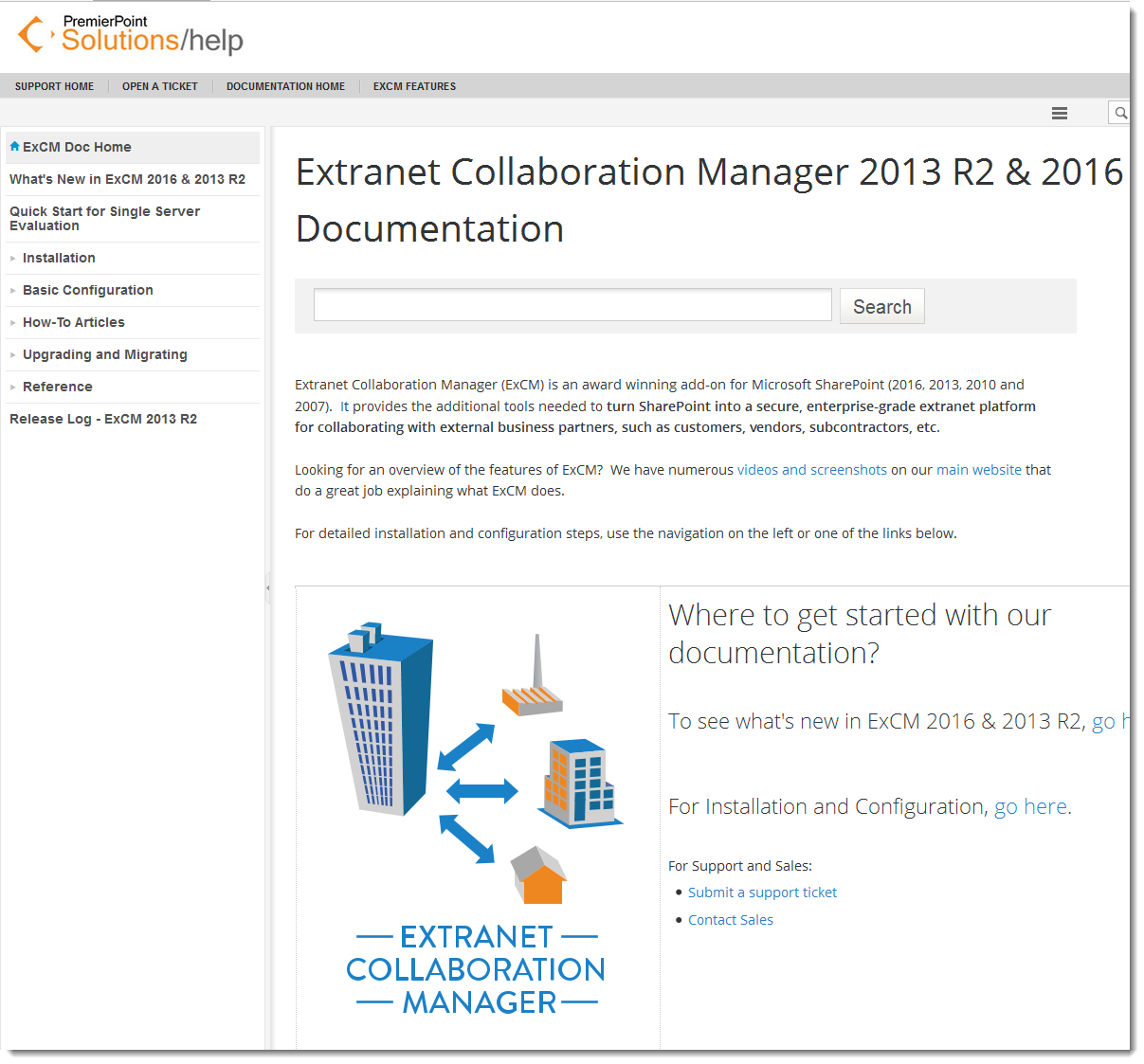ExCM 2013 R2 and ExCM 2016 are chock full of new and exciting features! Click the tabs on the left to learn about each of the new features.
Explore the New Features of ExCM 2013 R2 and ExCM 2016:
- Responsive Pages
- Multi-Factor Authentication
- Central Administration Components
- Multi-Server Farm Enhancements
- Extranet Setup Wizard
- Extranet Account Managers GUI
- Password Policies GUI
- Account & Password Expiration Policy GUI
- Global Registration Settings GUI
- Global Domain Settings GUI
- People Picker Restrictions GUI
- Extranet Site Directory Web Part
- Multiple Web Application Support
- Tagged and Expanded ULS Entries
- Re-written Documentation
Responsive Forms-based Sign In and Registration Pages
One of the important features of Extranet Collaboration Manager vs. out-of-the-box SharePoint is the custom SignIn.aspx page that ships with ExCM. To effectively use SharePoint in an extranet scenario with forms-based authentication you need a sign in page that accommodates both external users with FBA accounts and internal users with AD accounts. ExCM’s page does both and adds numerous other features as well.
But, the existing ExCM SignIn.aspx page and the Register.aspx were not originally designed for the modern web, where the size of device screens can vary greatly. The web development industry’s preferred solution to this is what is referred to as “responsive” page design. So, ExCM now ships with the existing non-responsive Sign In and Registration pages, as well as all-new “responsive” pages. Its your choice which version you deploy to your extranet – both sets have all the same features.
Here is an example of the type of experience you can accomplish with these new responsive pages:
The new responsive SignIn.aspx page on an iPhone Plus:
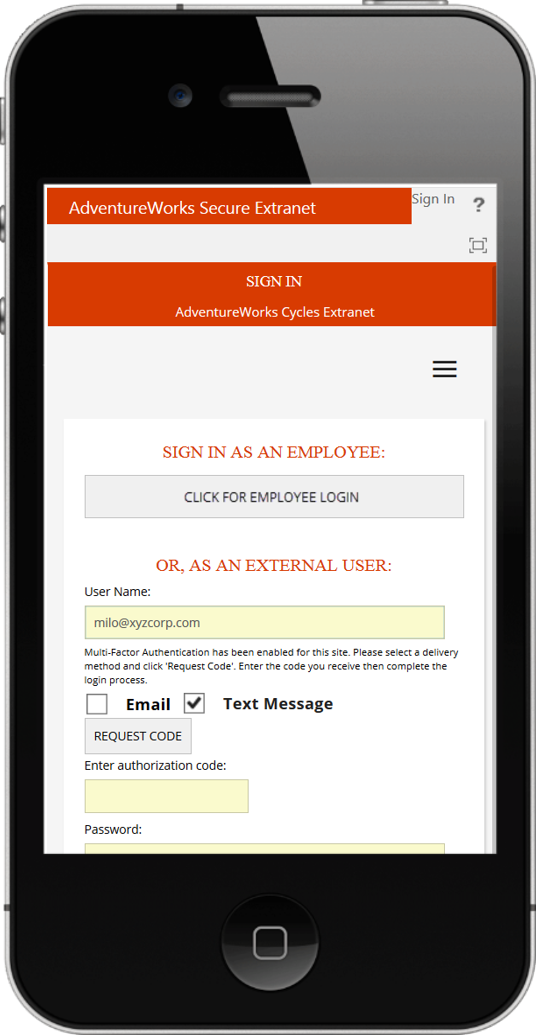
→ works great when paired with a responsive SharePoint theme:
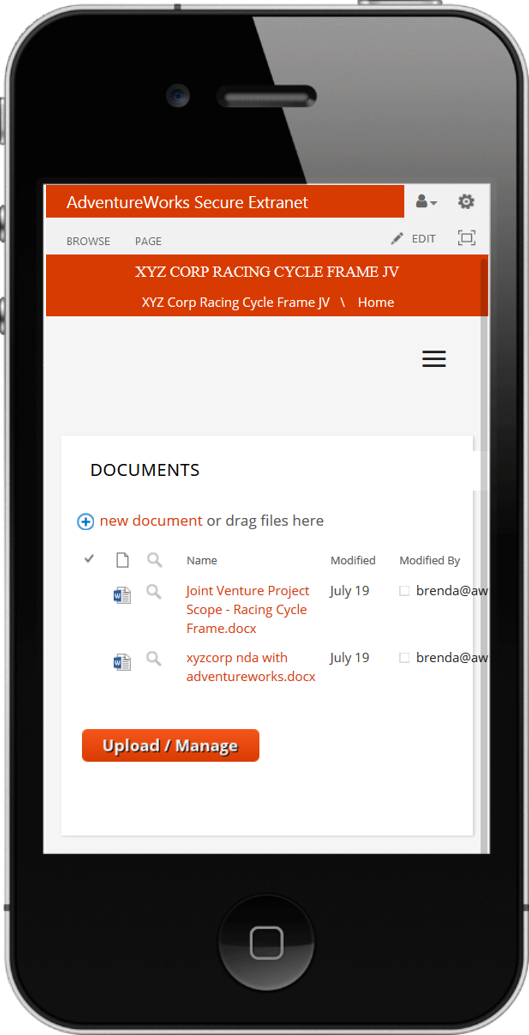
Integrated Multi-factor Authentication Add-on
ExCM 2013 R2 and ExCM 2016 now offer a native add-on that provides multi-factor authentication support! It is built right into the customizable sign-in page that ships with the product – no need to use a third-party multi-factor authentication service!
Here is a screenshot of the feature in action on a slightly customized version of the out-of-box page:
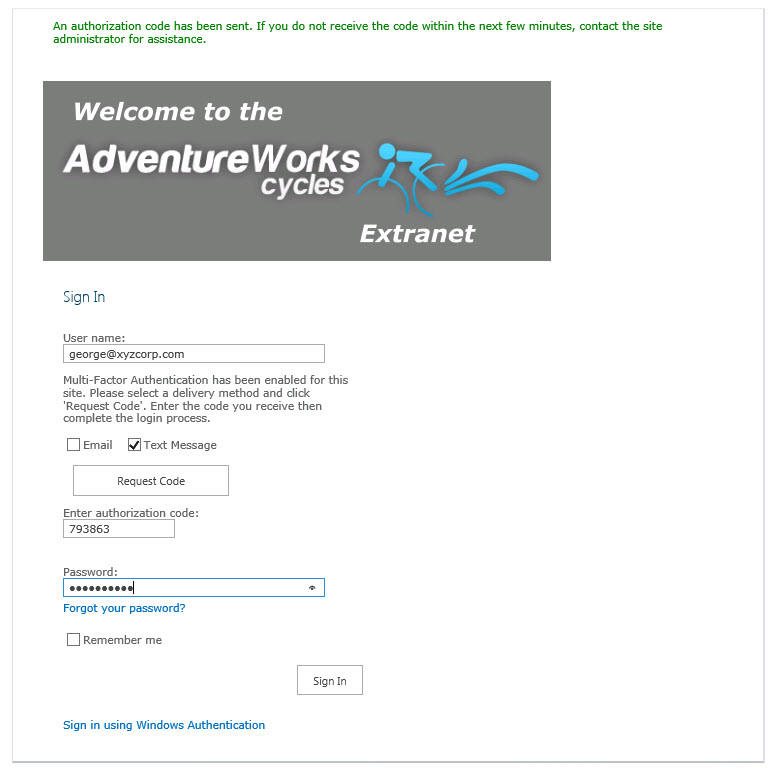
Important Note: Multi-factor Authentication is an add-on module that is available for ExCM 2013 R2 and ExCM 2016 only. Please contact us for pricing and details.
Central Administration Components
ExCM has always had a long list of advanced features such the ability to define specific password policy settings, global registration settings, and more. However, the configuration of these advanced features has required manual web.config file edits and\or Powershell commands. No more!
The new set of Central Administration components give you access to all of these settings via a convenient GUI:
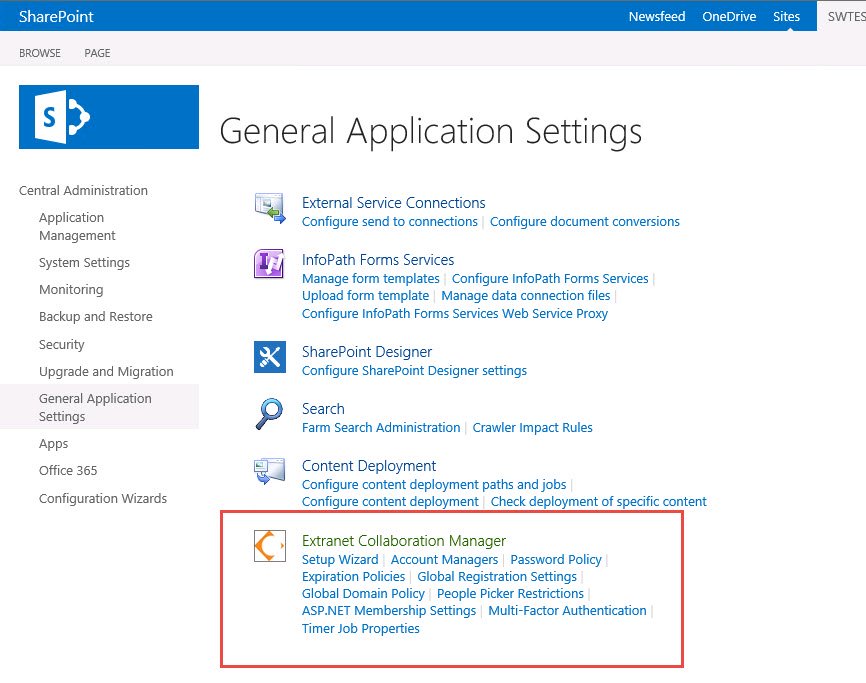
Multi-Server Farm Enhancements
These days, there are very few single-server SharePoint deployments. Organizations of every size desire to take advantage of SharePoint’s ability to provide fault tolerance and load balancing by running a properly configured multi-server farm.
ExCM has always been ready for SharePoint farms of any size, but the proper configuration of web.config files, which is necessary to support forms-based authentication, has always be an even greater challenge the larger a SharePoint farm becomes.
ExCM 2013 R2 and ExCM 2016 take away all of the pain of configuring forms-based authentication in a multi-server SharePoint farm, regardless of how many servers you have! This is accomplished via a new Extranet Global Configuration Timer Job infrastructure that automatically carries out your configuration and administrative instructions on every server in your SharePoint farm!
Here is a look at a control page in ExCM 2013 R2 Central Administration where fine-grained timer job operations can be managed:
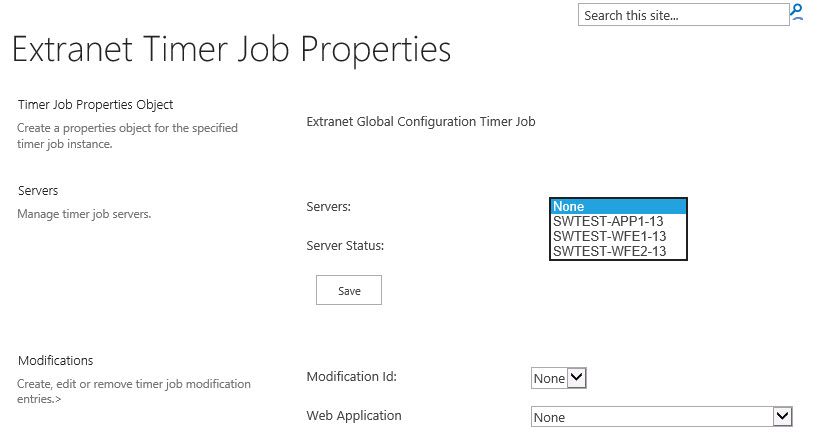
Extranet Setup Wizard
Setting up an extranet in SharePoint is typically a one-time task, but historically it has been a tedious and trial-and-error process for most SharePoint Farm Administrators due to the requirements to modify web.config XML files and create SQL databases and assign permissions to service accounts. Depending on the size of your farm, it might take a few days (and plenty of frustration!) of configuring and troubleshooting to get everything set up properly.
ExCM 2013 R2 and ExCM 2016 take away all of the pain associated with setting up a SharePoint web application to use Forms-based Authentication and the ASP.NET SQL Membership Provider.
The new one-page Extranet Setup Wizard in ExCM 2013 R2 and ExCM 2016 takes only a minute to fill out and then five minutes later all of the web.config files in your farm have been accurately modified (by the ExCM timer job) and your new extranet directory database will have been created and appropriate permissions automatically assigned! Your extranet web application is ready to go in under 10 minutes – no matter the size of your farm!
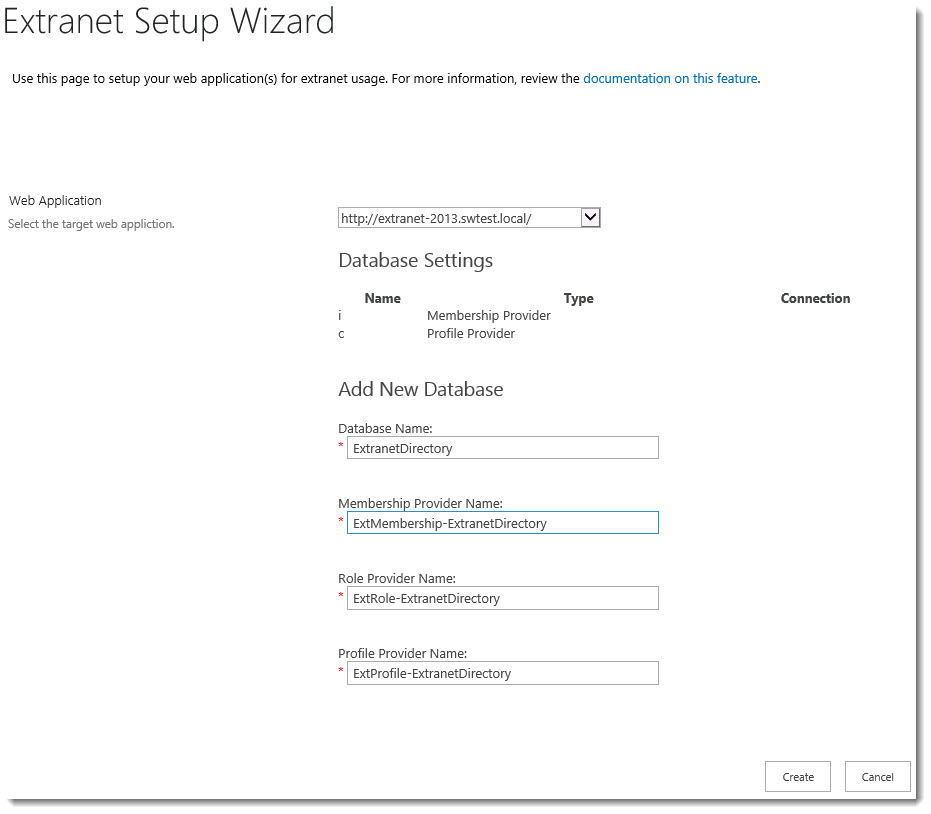
Extranet Account Managers GUI
Extranet Account Managers are typically SharePoint Administrators who are given the ability for full management of external user accounts that are stored in the extranet account directory. The concept is similar to Windows Domain Administrators who have full management capabilities over internal user accounts stored in Active Directory.
In ExCM 2013 R2 and ExCM 2016, a full GUI is provided to easily add and remove Extranet Account Managers:
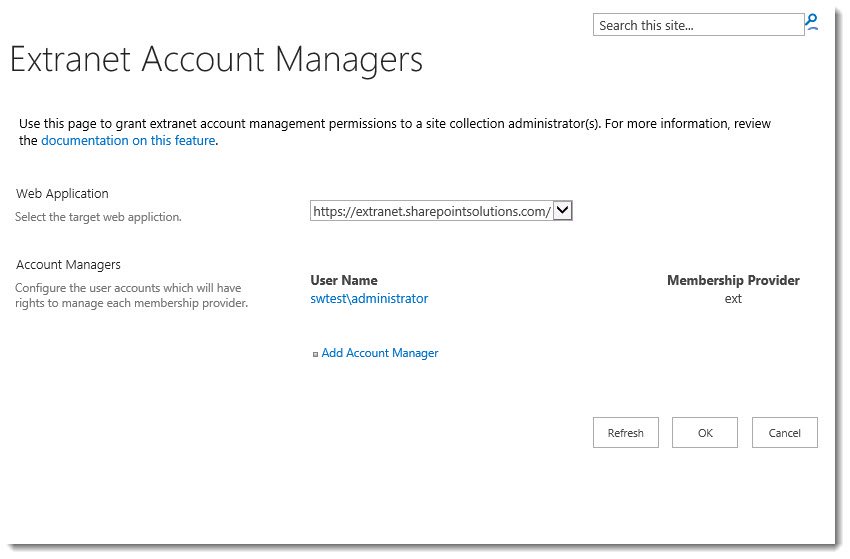
Password Policies GUI
ExCM 2013 R2 and ExCM 2016 provide an easy-to-use GUI to set your Password Policy for extranet users. Full control over password strength rules and failed attempt handling is provided:
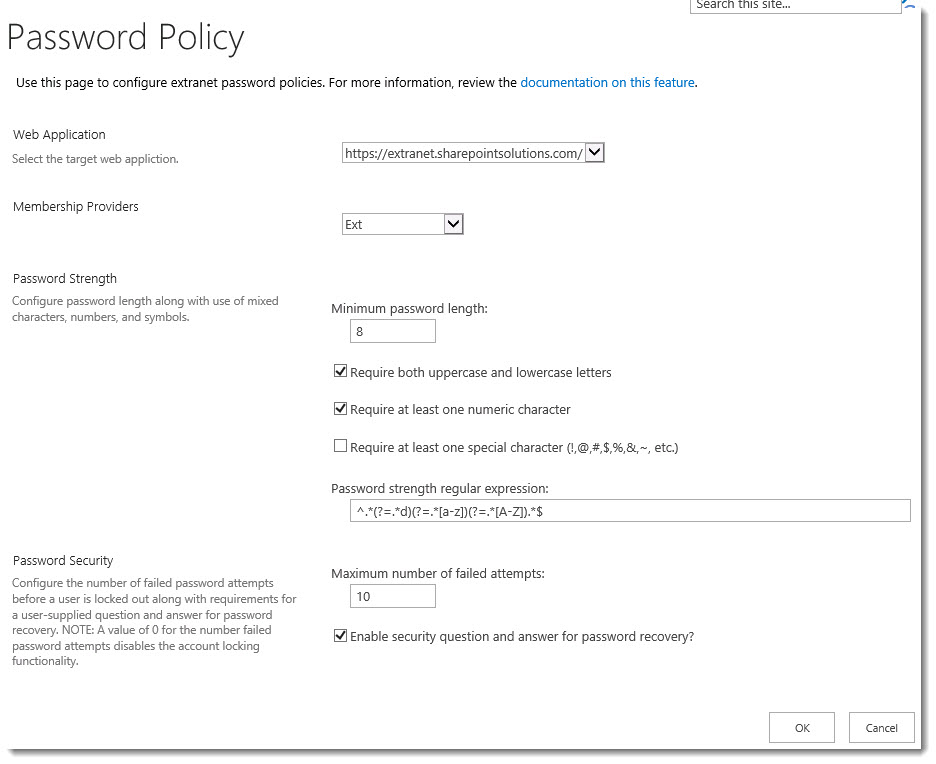
Account and Password Expiration Policy GUI
ExCM 2013 R2 and ExCM 2016 provide a timer job that can be scheduled to examine the last login date and last password change date for each extranet user account in your extranet directory. Now, the settings for this feature can be easily managed via Central Administration:
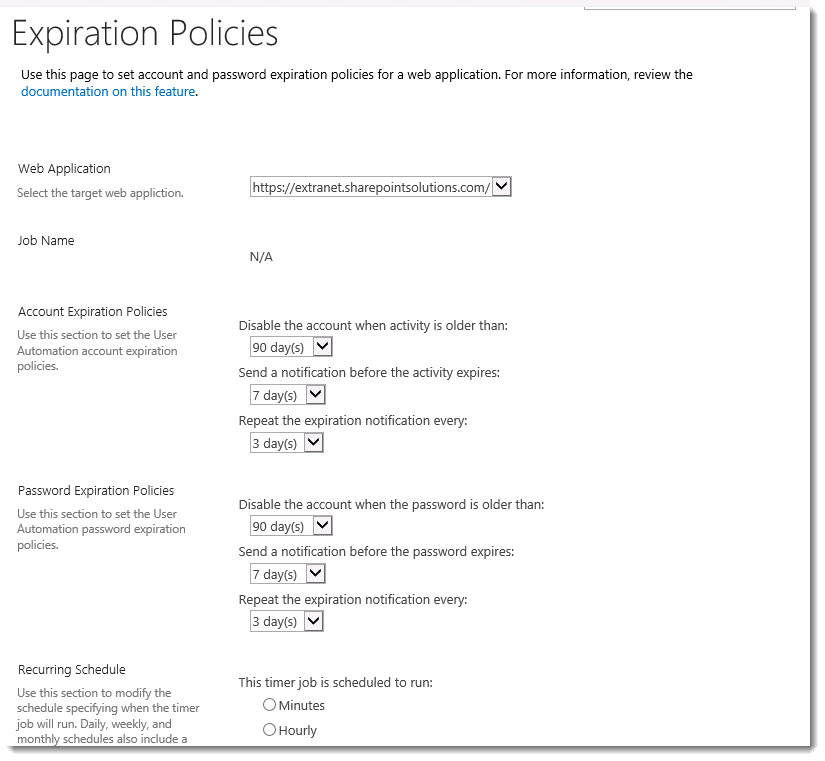
Global Registration Settings GUI
Many organizations like to capture various pieces of information when an external user registers for access to the extranet site. ExCM 2013 R2 and ExCM 2016 support easily adding global registration fields to the registration form via the new Global Registrations Settings interface:
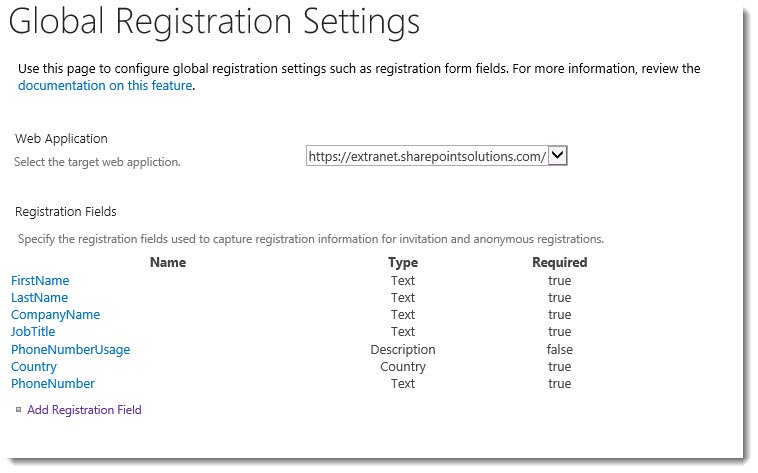
Global Domain Settings GUI
ExCM allows you to create site-level and global domain name inclusion and exclusion policies. At the site level, many businesses want to restrict a particular site (a customer collaboration site, for instance) to only external users who have email addresses from a specific domain. At the global level some businesses want to exclude common “free” email domains (gmail.com, hotmail.com, etc.) from ever being able to sign-in to any extranet site in their web application.
ExCM 2013 R2 and ExCM 2016 provide a new user interface for easily specifying global inclusion and\or exclusion domain name policies:
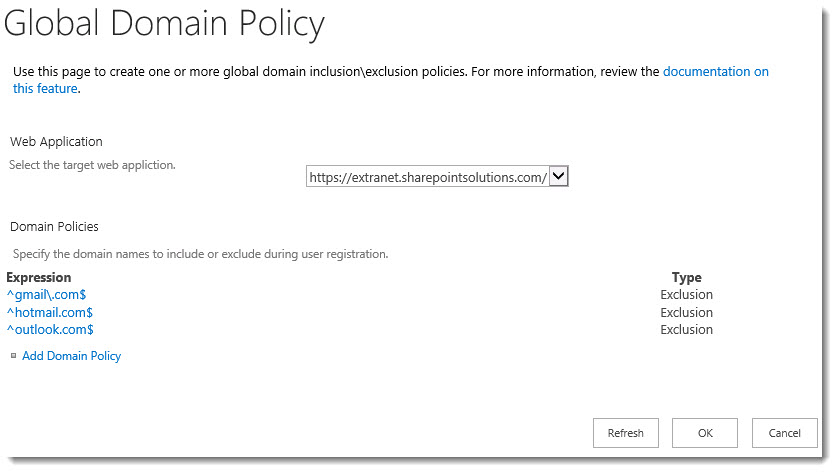
People Picker Restrictions GUI
In some extranet scenarios it is beneficial to modify SharePoint’s default search settings for the People Picker control. This occurs most often when the organization’s policy is to provision distinct Site Collections for each customer, vendor or other external business partner. In these scenarios, security and privacy can be enhanced by restricting the People Picker to only be able to search in the current Site Collection.
ExCM 2013 R2 and ExCM 2016 make it easy to enable these restrictions:
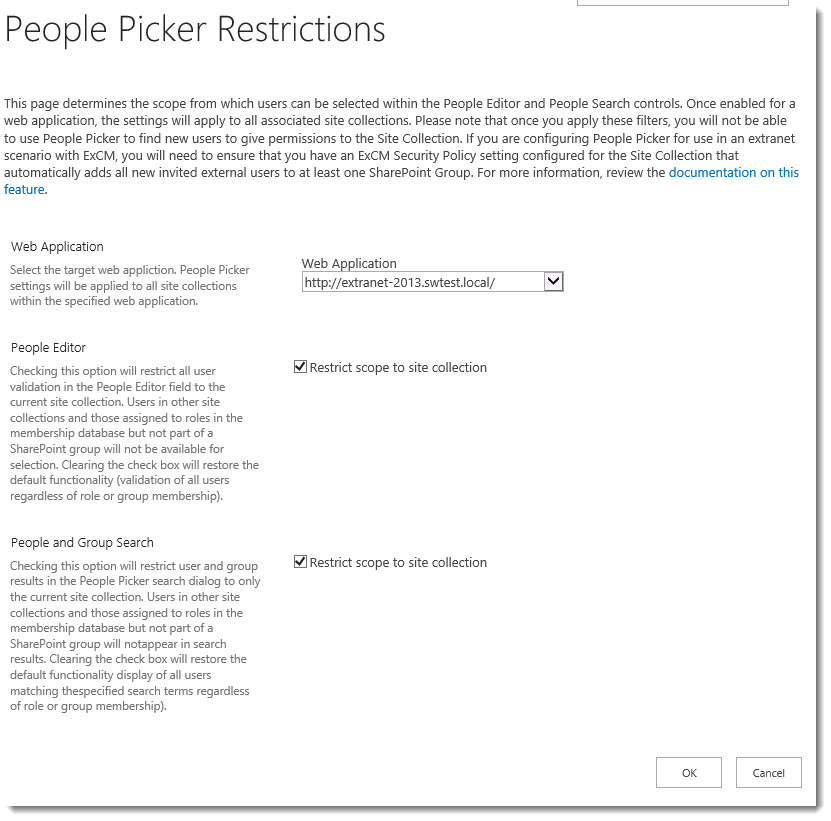
Extranet Site Directory Web Part
In some extranet scenarios, it may be beneficial to provide a landing page for external users and display a directory on the page of all of the extranet sites that the external user has permissions to access.
An example might be a construction company that has multiple projects underway and a subcontractor has been given permissions to the extranet sites for the specific projects they are assisting with. With the new Extranet Directory Web Part added to a landing page, the subcontrator can see a list of project sites they have access to and click on the links to navigate to the sites.
The Extranet Directory Web Part can be used for any scenario where you need to display a security-trimmed list of the extranet sites an extranet user has access to. Here is an example:
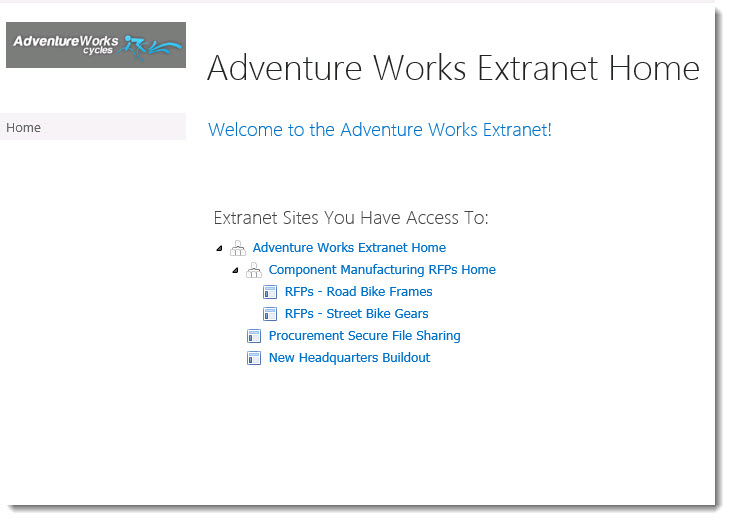
Multiple Web Application Support
Some organizations prefer to keep different types of extranets as completely separate as possible within a single SharePoint farm by provisioning a web application for each type of extranet. An example would be an organization that wants its customer extranet user accounts and sites to be completely separate from its vendor extranet user accounts and sites. Another example might be to have a separate extranet web application for different geographical regions of an organization.
ExCM 2013 R2 and ExCM 2016 make it very easy to have multiple extranet web applications in these types of scenarios. Consider the following example:
Adventure Works Bikes wants completely separate extranet web applications for customers and vendors. So, they provision separate web applications:
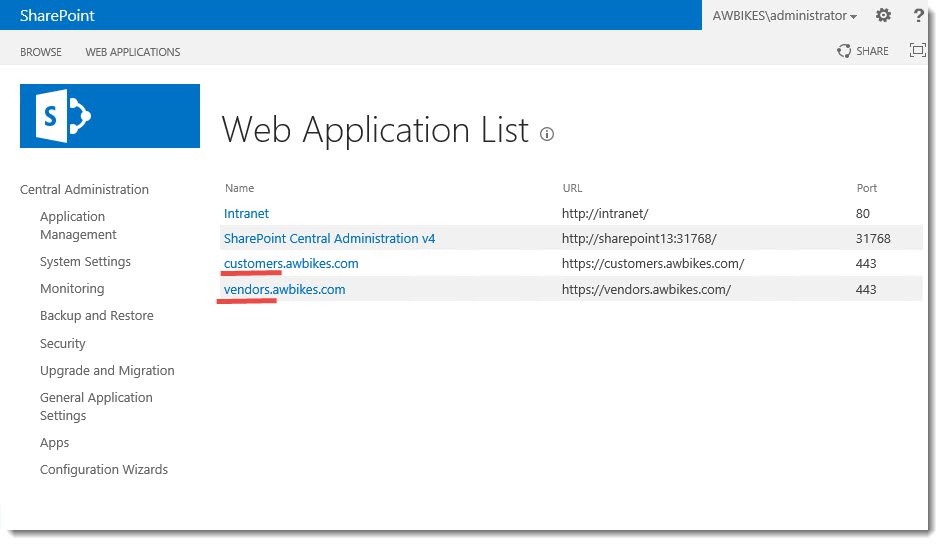
Next, they use the ExCM Setup Wizard to configure each of the web applications to have their own external user account database and own membership, role and profile providers:
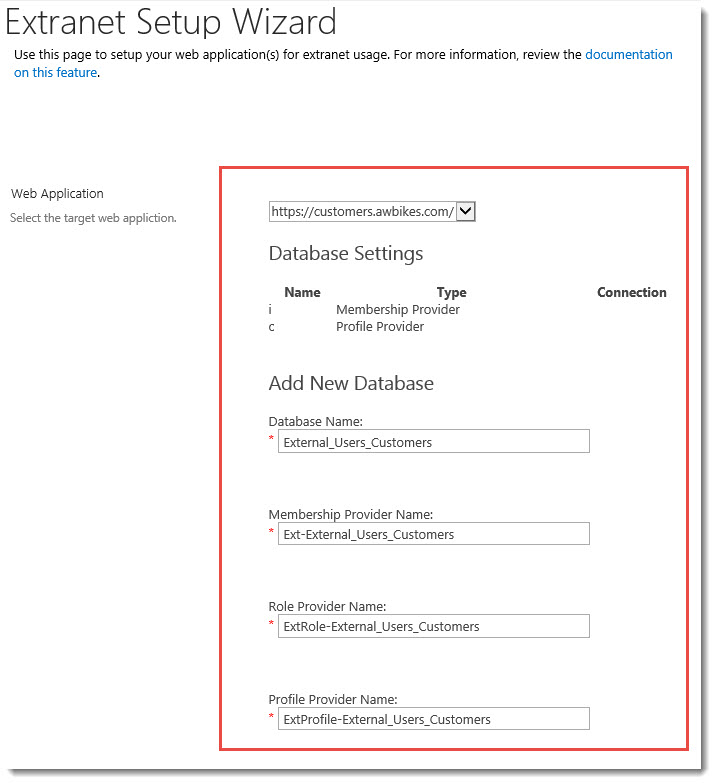
After the wizard completes its work, distinct databases have been created and configured to store the external accounts for customers and vendors completely separately:
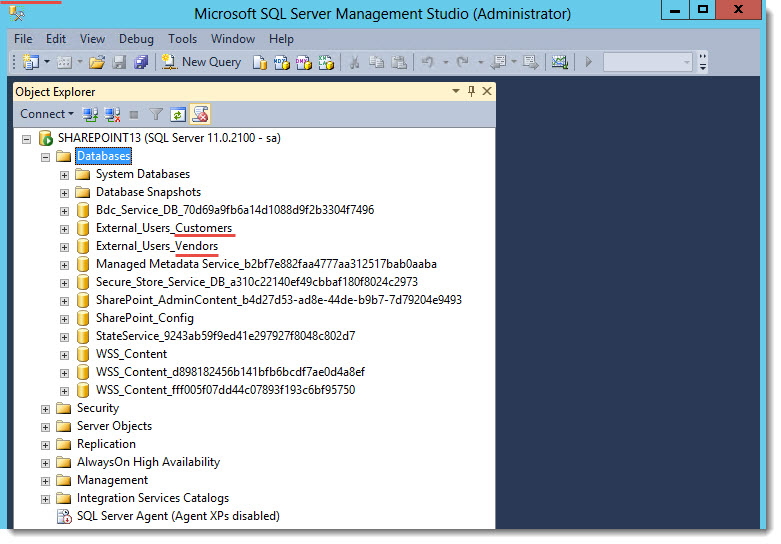
Tagged and Expanded ULS Entries
The power and comprehensive nature of SharePoint is one of its hallmarks as a business application platform. Unfortunately, all that power and expanse comes at a price – under-the-hood technical complexity.
ExCM 2013 R2 and ExCM 2016 are designed to give SharePoint Farm Administrator’s as many tools as possible with which to troubleshoot when things go wrong. In that vein, numerous new ULS (Universal Logging Service) entries have been baked into the software and properly tagged (filter on “Product contains ‘extranet’) so that you can see the configuration actions the software is taking on your behalf.
Here is an example of using the popular ULSViewer utility to examine these new entries in a properly filtered “Live” view of the ULS logs in a multi-server SharePoint farm:
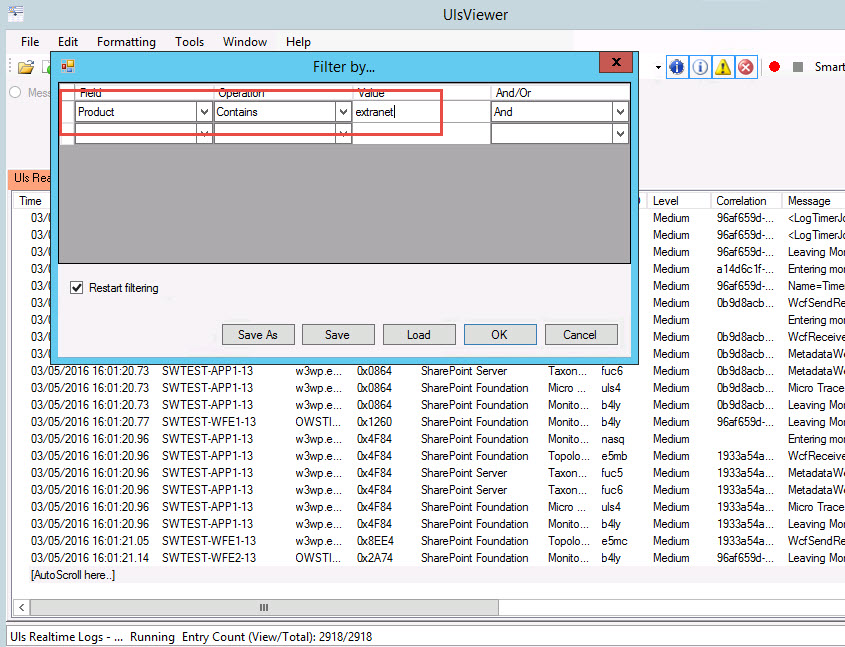
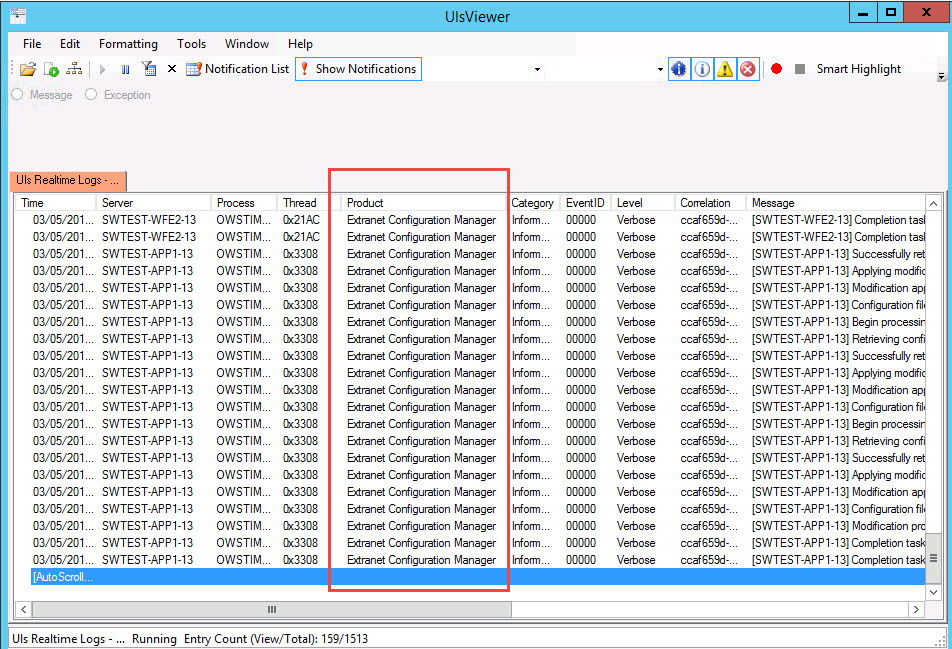
Re-written Documentation
We’ve completely re-organized and re-written our documentation for ExCM 2013 R2 and ExCM 2016. Administrators that are new to ExCM will be able to get up and going much easier than would have been possible in the past. Existing 2013 R1 Administrators will find much-improved, easy-to-follow instructions for configuring ExCM’s many advanced features.
Visit the new documentation site and check it out!
